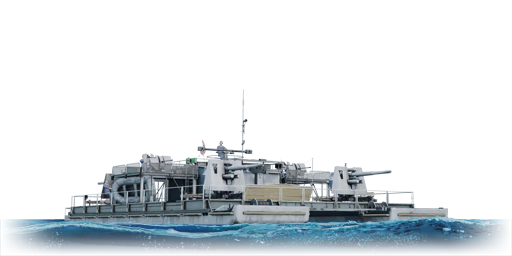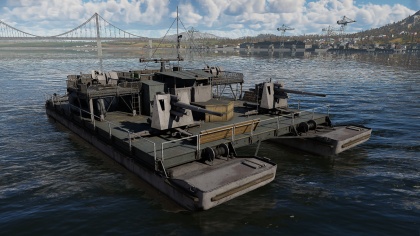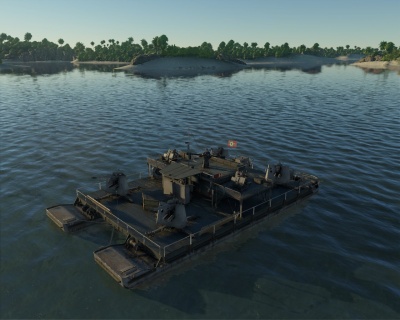Difference between revisions of "SF40 Heavy"
(→Mobility) (Tag: Visual edit) |
(Edits) |
||
| Line 2: | Line 2: | ||
== Description == | == Description == | ||
| − | <!--''In the first part of the description, cover the history of the | + | <!-- ''In the first part of the description, cover the history of the ship's creation and military application. In the second part, tell the reader about using this ship in the game. Add a screenshot; if a beginner player has a hard time remembering vehicles by name, a picture will help them identify the ship in question.'' --> |
[[File:GarageImage_{{PAGENAME}}.jpg|420px|thumb|left]] | [[File:GarageImage_{{PAGENAME}}.jpg|420px|thumb|left]] | ||
| − | {{ | + | {{Break}} |
| − | The '''{{Specs|name}}''' is a | + | The '''{{Specs|name}}''' is a rank {{Specs|rank}} German anti-air ferry {{Battle-rating}}. It was introduced in [[Update 1.79 "Project X"]] in the fleet closed beta test. |
== General info == | == General info == | ||
=== Survivability and armour === | === Survivability and armour === | ||
| − | <!--''Talk about the | + | <!-- ''Talk about the vehicle's armour. Note the most well-defended and most vulnerable zones, e.g. the ammo magazine. Evaluate the composition of components and assemblies responsible for movement and manoeuvrability. Evaluate the survivability of the primary and secondary armaments separately. Don't forget to mention the size of the crew, which plays an important role in fleet mechanics. Save tips on preserving survivability for the "Usage in battles" section. If necessary, use a graphical template to show the most well-protected or most vulnerable points in the armour.'' --> |
| − | |||
| − | |||
SF40 Schwere has the following armour layout: | SF40 Schwere has the following armour layout: | ||
| Line 24: | Line 22: | ||
=== Mobility === | === Mobility === | ||
| + | ''Write about the ship's mobility. Evaluate its power and manoeuvrability, rudder rerouting speed, stopping speed at full tilt, with its maximum forward and reverse speed.'' | ||
== Armament == | == Armament == | ||
=== Primary armament === | === Primary armament === | ||
| + | <!-- ''Provide information about the characteristics of the primary armament. Evaluate their efficacy in battle based on their reload speed, ballistics and the capacity of their shells. Add a link to the main article about the weapon: <code><nowiki>{{main|Weapon name (calibre)}}</nowiki></code>. Broadly describe the ammunition available for the primary armament, and provide recommendations on how to use it and which ammunition to choose.'' --> | ||
{{main|Flak.36 (88 mm)}} | {{main|Flak.36 (88 mm)}} | ||
| − | The 8 | + | |
| + | The 8.8 cm FlaK guns mounted on the SF 40 Schwere have a really good reload rate, accuracy and muzzle velocity thus making it easy to aim and control. The access to distance-fuse high-explosive shells and an elevation up to 85° degrees is very effective against big attackers and bombers flying high and slow. The reload rate also makes the SF40 a really dangerous opponent. | ||
=== Secondary armament === | === Secondary armament === | ||
| + | <!-- ''Some ships are fitted with weapons of various calibres. Secondary armaments are defined as weapons chosen with the control <code>Select secondary weapon</code>. Evaluate the secondary armaments and give advice on how to use them. Describe the ammunition available for the secondary armament. Provide recommendations on how to use them and which ammunition to choose. Remember that any anti-air armament, even heavy calibre weapons, belong in the next section. If there is no secondary armament, remove this section.'' --> | ||
{{main|2 cm/65 C/38 (20 mm)}} | {{main|2 cm/65 C/38 (20 mm)}} | ||
| − | |||
| − | == | + | The 20 mm multi-purpose cannons with a fire rate of 480 rounds/min is very effective against small boats and lightly armoured ships as well as planes in close combat thus making the SF 40 also effective against light and fast naval and air targets. |
| − | ''Describe the technique of using this ship, the characteristics of her use in a team and tips on strategy. Abstain from writing an entire guide – | + | |
| + | == Usage in battles == | ||
| + | ''Describe the technique of using this ship, the characteristics of her use in a team and tips on strategy. Abstain from writing an entire guide – don't try to provide a single point of view, but give the reader food for thought. Talk about the most dangerous opponents for this vehicle and provide recommendations on fighting them. If necessary, note the specifics of playing with this vehicle in various modes (AB, RB, SB).'' | ||
=== Pros and cons === | === Pros and cons === | ||
| − | <!--'' | + | <!-- ''Summarise and briefly evaluate the vehicle in terms of its characteristics and combat effectiveness. Mark its pros and cons in the bulleted list. Try not to use more than 6 points for each of the characteristics. Avoid using categorical definitions such as "bad", "good" and the like - use substitutions with softer forms such as "inadequate" and "effective".'' --> |
'''Pros:''' | '''Pros:''' | ||
| Line 57: | Line 60: | ||
== History == | == History == | ||
| − | <!--''Describe the history of the creation and combat usage of the ship in more detail than in the introduction. If the historical reference turns out to be too | + | <!-- ''Describe the history of the creation and combat usage of the ship in more detail than in the introduction. If the historical reference turns out to be too long, take it to a separate article, taking a link to the article about the ship and adding a block "/History" (example: <nowiki>https://wiki.warthunder.com/(Ship-name)/History</nowiki>) and add a link to it here using the <code>main</code> template. Be sure to reference text and sources by using <code><nowiki><ref></ref></nowiki></code>, as well as adding them at the end of the article with <code><nowiki><references /></nowiki></code>. This section may also include the ship's dev blog entry (if applicable) and the in-game encyclopedia description (under <code><nowiki>=== In-game description ===</nowiki></code>, also if applicable).'' --> |
| − | The Siebelfähre was designed by Friedrich Siebel, owner of a lesser-known German aircraft manufacturing company bearing his name. | + | The Siebelfähre was designed by Friedrich Siebel, owner of a lesser-known German aircraft manufacturing company bearing his name. Siebel's idea was to provide the German army with a much needed easily mass-produced and effective transport vessel for the planned invasion of Britain. |
His ferry would be a construction utilising parts of Bailey bridges and pontoons, which would make up the two barges connected in a catamaran style by a wooden deck. The vessel was supposed to be powered by aircraft engines and could easily be disassembled and reassembled thanks to its modular construction, allowing for the boat to also be transported by land. | His ferry would be a construction utilising parts of Bailey bridges and pontoons, which would make up the two barges connected in a catamaran style by a wooden deck. The vessel was supposed to be powered by aircraft engines and could easily be disassembled and reassembled thanks to its modular construction, allowing for the boat to also be transported by land. | ||
| Line 66: | Line 69: | ||
However, before all 400 vessels could be made, the Invasion of Britain was cancelled, and thus the need for the Siebelfähre also disappeared below the waves. Nonetheless, around 200 of these vessels were still made before the order was cancelled and a majority of them found use in transport and mine-laying operations in the Black Sea and the Mediterranean. The Siebelfähre saw use right up to the end of the war, and some vessels continued serving well into the 1960s as civilian ferries. | However, before all 400 vessels could be made, the Invasion of Britain was cancelled, and thus the need for the Siebelfähre also disappeared below the waves. Nonetheless, around 200 of these vessels were still made before the order was cancelled and a majority of them found use in transport and mine-laying operations in the Black Sea and the Mediterranean. The Siebelfähre saw use right up to the end of the war, and some vessels continued serving well into the 1960s as civilian ferries. | ||
| − | ''- From [ | + | ''- From [[wt:en/news/5589-fleet-development-siebelf%C3%A4hre-sf-40-schwere-en|Devblog]]'' |
== Media == | == Media == | ||
| − | [[File:SF-40 (schwer).jpg|thumb]] | + | <!-- ''Excellent additions to the article would be video guides, screenshots from the game, and photos.'' --> |
| + | [[File:SF-40 (schwer).jpg|thumb|none|400px]] | ||
== See also == | == See also == | ||
| − | ''Links to | + | ''Links to articles on the War Thunder Wiki that you think will be useful for the reader, for example:'' |
| − | |||
* ''reference to the series of the ship;'' | * ''reference to the series of the ship;'' | ||
* ''links to approximate analogues of other nations and research trees.'' | * ''links to approximate analogues of other nations and research trees.'' | ||
== External links == | == External links == | ||
| − | <!--''Paste links to sources and external resources, such as:'' | + | <!-- ''Paste links to sources and external resources, such as:'' |
* ''topic on the official game forum;'' | * ''topic on the official game forum;'' | ||
| − | * ''encyclopedia page on ship;'' | + | * ''encyclopedia page on the ship;'' |
| − | * ''other literature.''--> | + | * ''other literature.'' --> |
| − | * [ | + | * [[wt:en/news/5589-fleet-development-siebelf%C3%A4hre-sf-40-schwere-en|[Devblog] Siebelfähre SF 40 Schwere]] |
{{Germany barges}} | {{Germany barges}} | ||
Revision as of 08:55, 20 May 2020
Contents
Description
The Siebelfähre 40 Heavy is a rank III German anti-air ferry
with a battle rating of 2.7 (AB/RB/SB). It was introduced in Update 1.79 "Project X" in the fleet closed beta test.
General info
Survivability and armour
SF40 Schwere has the following armour layout:
- 2 cm/65 C/38 automatic cannon gunshields: 8 mm, hardened armour
- 8,8 cm Flak.36 cannon gunshield: 8 mm, antifragmentation armour
- Deckhouse: 10 mm, rolled homogeneous armour
- Hull: 8 mm, steel
- Superstructure: 20 mm, steel
SF40 Schwere armour is basically same as SF40 Leichte with changes around guns. It lacks armoured turret platforms so guns taken out with HE shells might occur more often. Besides armour, Schwere can be a tough opponent to sink since most HE shots will hit the deck with no damage to the hull. Also, the rather high crew complement of 47 (5 more then Leichte) makes it harder to incapacitate by killing crew, though this is still the easiest way to take out this barge. Clever captains will try to angle the ship to allow aiming 3 guns on enemy targets, but this also makes the opposing ship able to hit only one of the four ammo storages. Even though this storage is high above the waterline, hitting it doesn't happen often since the bridge in the center is a way easier target to aim at.
Mobility
Write about the ship's mobility. Evaluate its power and manoeuvrability, rudder rerouting speed, stopping speed at full tilt, with its maximum forward and reverse speed.
Armament
Primary armament
The 8.8 cm FlaK guns mounted on the SF 40 Schwere have a really good reload rate, accuracy and muzzle velocity thus making it easy to aim and control. The access to distance-fuse high-explosive shells and an elevation up to 85° degrees is very effective against big attackers and bombers flying high and slow. The reload rate also makes the SF40 a really dangerous opponent.
Secondary armament
The 20 mm multi-purpose cannons with a fire rate of 480 rounds/min is very effective against small boats and lightly armoured ships as well as planes in close combat thus making the SF 40 also effective against light and fast naval and air targets.
Usage in battles
Describe the technique of using this ship, the characteristics of her use in a team and tips on strategy. Abstain from writing an entire guide – don't try to provide a single point of view, but give the reader food for thought. Talk about the most dangerous opponents for this vehicle and provide recommendations on fighting them. If necessary, note the specifics of playing with this vehicle in various modes (AB, RB, SB).
Pros and cons
Pros:
- Powerful 88 mm guns can destroy a target with just 1 or 2 hits
- Can take quite a few hits
- Velocity and flat trajectory of shells makes it suitable to hang back and snipe enemies from +2 km
Cons:
- Not very fast or manoeuvrable
- Large target
- Lacks an AP shell for dealing with armoured targets.
- The 37 mm fast firing flak on the SF40 Leichte is replaced by two single 20 mm mounts
- Hard to get all 4 cannons on target
- Easy to torpedo or dive bomb due to its size and sluggishness
- Lacks a VT-fuze shell, only has timed and impact fuzes
History
The Siebelfähre was designed by Friedrich Siebel, owner of a lesser-known German aircraft manufacturing company bearing his name. Siebel's idea was to provide the German army with a much needed easily mass-produced and effective transport vessel for the planned invasion of Britain.
His ferry would be a construction utilising parts of Bailey bridges and pontoons, which would make up the two barges connected in a catamaran style by a wooden deck. The vessel was supposed to be powered by aircraft engines and could easily be disassembled and reassembled thanks to its modular construction, allowing for the boat to also be transported by land.
The idea was met with great enthusiasm from the German military, and an order for 400 of this ferrycraft soon followed. The order encompassed more than just one version of the vessel, however. For instance, some versions were specialised to perform anti-air duties and were meant to cover the landing troops from air attacks. These were equipped with light 20mm and 37mm AA guns up to the heavy FlaK 88mm cannon, depending on the version.
However, before all 400 vessels could be made, the Invasion of Britain was cancelled, and thus the need for the Siebelfähre also disappeared below the waves. Nonetheless, around 200 of these vessels were still made before the order was cancelled and a majority of them found use in transport and mine-laying operations in the Black Sea and the Mediterranean. The Siebelfähre saw use right up to the end of the war, and some vessels continued serving well into the 1960s as civilian ferries.
- From Devblog
Media
See also
Links to articles on the War Thunder Wiki that you think will be useful for the reader, for example:
- reference to the series of the ship;
- links to approximate analogues of other nations and research trees.
External links
| Germany barges | |
|---|---|
| Anti-air ferries | SF40 Light · SF40 Heavy |
| Naval ferry barges | AF D1 · AF D3 |






